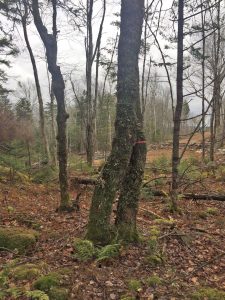And in Nova Scotia, after the feller bunchers have gone, and with them, the sugar maple and the birds nests and the salamander habitat, silence reigns supreme, especially the silence from NSDNR on the subject of forest soil nutrient deficits
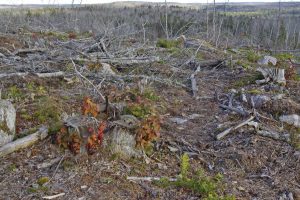
“Clearcut on Crown land in the Oak Lake area west of Lake Paul, fall 2017. It was a hardwood hill (predominantly sugar maple/red maple) overlooking the lake. A local maple syrup producer would have leased the Crown property for a sugar bush.” – Bob Bancroft.
Click on photo for a larger version
I have commented before on losses of nutrients, especially calcium, in forest soils over a large portion of the Nova Scotia landscape due to acid rain combined with the the inherently poor buffering capacity of forest soils developed on slates, granites and felsic bedrock on about 60% of our landscape. Clearcutting increases the losses through direct removal in harvested biomass and through increased leaching and loss of topsoil.
The loss of calcium in particular has been recognized as a major ecological issue for forests in northeastern North America affected by acid rain. Declines in calcium under forests are having diverse adverse effects either through calcium deficiency directly or indirectly through enhanced aluminum mobilization and mercury toxicity, effects being observed on zooplankton, forest herbs, invertebrates, song birds, cold tolerance of red spruce , sugar maple decline, loon reproduction.

Map shows watersheds of the endangered Southern Upland salmon populations and the average pH of surface waters. Salmon populations in SW Nova Scotia have been the most severely impacted by acid rain. “Salmon populations in extremely acidified systems ([RED] pH <4.7) are thought to be extirpated (13 rivers), reduced by 90% in moderately impacted systems ([YELLOW] pH = 4.7-5.0; 20 rivers), reduced by about 10% in slightly impacted systems (pH = 5.1-5.4; 14 rivers), and apparently unaffected when pH >5.4 (13 rivers) based on research in the 1980s.” Click on the image for a larger version and source.
In 2008-2010 NSDNR began to investigate and model soil nutrients as a factor to be considered in relation to the sustainability of harvests, especially harvesting for biomass energy. A report by Kevin Keys (NSDNR soil scientist) and others on some of this research was published in the scientific literature in 2016. It demonstrated clearly the extent and severity of nutrient deficits and provided an example of impacts of and on harvests:
Based on comparisons with NBM-NS [Nutrient Budget Model—Nova Scotia] output, approximately 1/4 to 1/2 of the [25] assessed plantation sites have non-sustainable MMAI [merchantable mean annual increment] yield expectations…Plantations with non-sustainable MMAI values are mainly associated with low soil weathering classes (especially Class 1) and/or tree species with high nutrient demands (e.g., Norway spruce). – A Simple Geospatial Nutrient Budget Model for Assessing Forest Harvest Sustainability across Nova Scotia, Canada by Kevin Keys et al. 2016. Open Journal of Forestry 6: 420-444.
Remarkably, in 2018, NSDNR has yet to implement any consideration of nutrients in Crown land harvest decisions or even to highlight the issue as one that we need to be very concerned about.
Keys’ paper is one of the few pieces of NSDNR forestry science submitted to a peer reviewed science journal, and it reports results that have big implications for forests and forestry in Nova Scotia, yet the work was not mentioned in the recent State of the Forest report, nor can I find any mention of the work on the DNR website, e.g. it’s not listed under on a Soils and Water page or Under Ecosystem Management > Tools.
Keys, a very diligent researcher, rails at such comments, insisting that they need more data and to improve the model before they can implement nutrient budgeting in their Crown lands harvest decision process and that it would be irresponsible to put anything out before that’s achieved.
But why can’t they talk about and apply in a precautionary way what we do know with a high degree of certainty now? We know, for example, that forested lands in SW Nova Scotia are especially prone to significant nutrient deficiencies, that clearcutting increases nutrient losses and we know from the work of aquatic scientists which watersheds are highly acidified (see map above) and hence in which watersheds clearcutting should really be avoided.
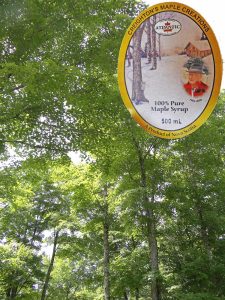
Sugar maples on the woodlot of the late Wilf Creighton, and product label
A good (but unfortunate) example of how the lack of any precautionary action on the issue may be undermining the future of our forests and options for utilizing them is provided by a recent paper based on a long term study at the Hubbard Brook Ecosystem Study site in New Hampshire.
That research and also research in Quebec provides evidence that on moderately acidified soils, clearcutting can reduce the soil calcium levels to an extent that regeneration of sugar maple is impaired; at the same time, American beech – now problematical in eastern regions because most of it is diseased – is favoured, complicating efforts to reduce its abundance.
The significance of “acidified soils” is that these are soils with moderate to low levels of soil calcium to begin with, the situation over much of Nova Scotia. I am guessing – perhaps I should say it’s an informed guess – that there is high likelihood that sugar maple found today on moderately to strongly acidified sites in SW Nova Scotia got established when calcium levels were higher 30+ years ago and is hanging on because of calcium accumulated in its earlier years – and that, as at the New Hampshire site, it won’t regenerate well after a clearcut.
After the feller bunchers have gone, and with them, the sugar maple and the birds nests and the salamander habitat, silence reigns supreme, especially the silence from NSDNR on the subject of forest soil nutrient deficits in Nova Scotia.
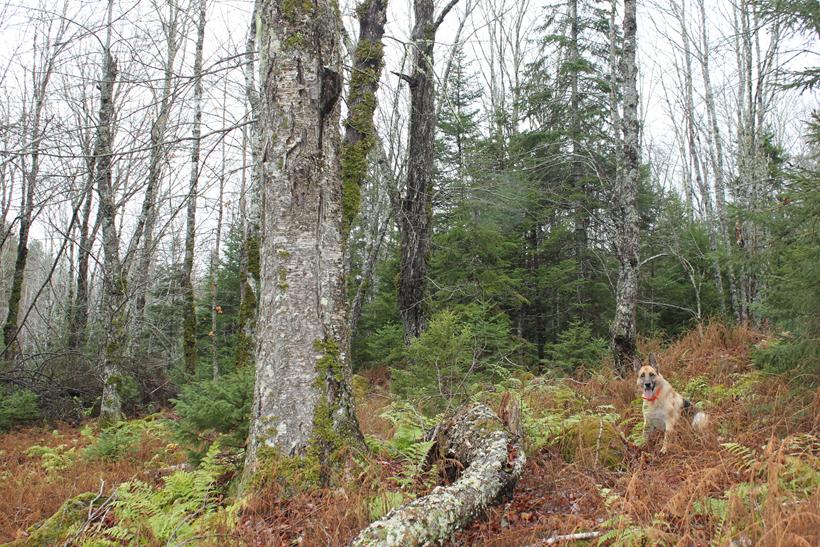
“A small pocket of sugar maple-yellow birch that somehow escaped a forest fire some 80 + years ago. This pocket was included within a clearcut polygon and is now ‘gone’. DNR’s response to my concerns about clearcutting these older, late-successional trees was the offer that they could make it an ‘inclusion’ if the trees were marked, but they didn’t offer to go flag it. The woods around these trees were in the process of recovering nicely from the fire, with white birch dropping out of the system and tolerant species returning, but now the land has been assaulted by yet another human-caused disturbance; a clearcut. I was told that it would be unreasonable to expect the guy on the harvester to distinguish sugar maple from red maple when harvesting our Crown woodlands. I disagree. DNR’s simplified PTA polygons should not replace good decision-making on the ground for these pockets of survivors and our last sugar maples” – Donna Crossland
LINKS
New Hampshire
Long-term decline of sugar maple following forest harvest, Hubbard Brook Experimental Forest, New Hampshire Natalie L. Cleavitt et al., 2018. Canadian Journal of Forest Research 48(1): 23-31
SUMMARY on hubbardbrook.org (bolding mine):
In 1985 we conducted a whole-tree harvest experiment on W5 to evaluate how forest ecosystems respond to this intensive forest management practice and associated high nutrient removal. Periodic measurements on permanent plots across W5 have revealed that sugar maple abundance has drastically
declined during thirty years of forest development on W5. Sugar maple comprised nearly half of the forest basal area at the time of whole-tree harvest and now has been relegated to be a minor species, making up less than 4% of forest basal area watershed-wide. The decline in maple abundance was most striking after age 10, as initially regeneration appeared adequate. The decline was most intense in the upper slope positions on W5 where soils have been most severely depleted of calcium by the combination of acid rain and repeated forest harvest. We suggest that low soil calcium availability limits the ability of sugar maple to compete effectively with other tree species like birches and beech. We conclude that forest managers will need to take special care to protect advanced regeneration of heavily cut forests on acidified soils in the eastern United States if they hope to maintain the place of sugar maple in managed forest landscapes.
Study: N.H. sugar maples have a very hard time returning after a clear-cut harvest
By David Brooks in Concord Monitor, March 27, 2018
Some related posts, op-ed
What’s good for salmon is good for trees in Nova Scotia…and v. versa!
Dec 13, 2016
OPINION: Acid rain + clear cuts = permanent loss
David Patriquin, Chronicle Herald, May 6, 2016
On clearcutting of sugar maple in NS
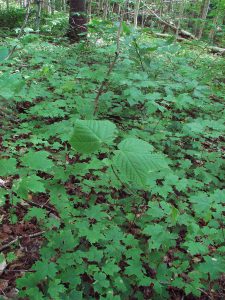 Wentworth Valley clear cutting raises concerns
Wentworth Valley clear cutting raises concerns
Truro Daily News, June 18, 2017
COMMENTARY: Chipping our forests on the cheap
Bob bancroft in the Chronicle Herald, February 6, 2018
Annapolis County clearcut frustrates neighbours
CBC, feb 3, 2017
Questions to NSDNR about forest nutrients and NSDNR response
View Halifax Field Naturalists: Impacts of forestry in Nova Scotia on conservation of biodiversity: Concerns and Questions
A Submission to Nova Scotia Department of Natural Resources April 2017 – View SECTION 7. SOIL ACIDIFICATION & LOSSES OF CALCIUM, with Questions Nos 20, 21 and 22 on pages 15-18; and NSDNR responses (Aug, 2017) to Questions 20, 21, 22
Some comments on WWNS
KT, Apr 1, 2018: Kevin is a great soil scientist (and the current president of RPFANS). And while I still firmly believe it is the landowners ultimate right to make an informed choice how to treat their woodlands, not much bugs me more than a tolerant hardwood clear-cut for this reason…well that and a butchered boundary line.
BW, Apr 1, 2018: It’s very frustrating that more “boots on the ground” assessment isn’t done before these tracts are designated for clearcutting. Why aren’t they properly vetted ahead of time by trained people? Why is it “too hard” for harvesters to avoid cutting down Sugar Maple because they can’t distinguish them from Red Maple? Why isn’t there auditing happening onsite during actually harvests – or a resource person onsite for consultation – is this being done? Would that be too hard – or is it too invasive having oversight during a harvest? How much follow-up is done after a cut — that year, and then in later years to see what’s happening — test the soil, test the watersheds, track the type of tree regeneration that occurs?
I just read an article linked to one of the other articles mentioned in the above piece. It was about someone in Annapolis County who had recently graduated from the Nova Scotia Community College’s natural resources environmental technology program. If we’re so worried about not having jobs for young people here in NS, why not hire some of these graduates to do site assessments – before and after these cuts? Further, put some of them to work doing proper research into tracts before they are designated for cutting.
A couple of days ago, in less than an hour, I was able to look up the NS Bird Atlas square map for that proposed clearcut in Shelburne County, and find what birds had been recorded in that square on two atlases. From what I could see, there are Canada Warblers in there (a Scehdule 1 Species at Risk “Threatened” species that breeds on forested wetland — and that’s what is supposed to be in that area — there are two large tracts of wetland in that cut). When I looked at the atlasing map, it was made by DNR a few years ago. From what I can see, the proposed cut is just a sort of overlay of all the areas marked as either mature conifer or “shrubby wetland” with little cut-outs around a couple of areas marked as mature deciduous.
So, my question — how accurate are these maps? How well does anyone really know these tracts? Quite aside from the example of the Bird Atllas data, what other scientific studies and records do we have from there there? Does anyone check on this kind of data and information before marking up the next tract of land for cutting? Why not send in some of these graduates from the Nova Scotia Community College’s natural resources environmental technology program and have them check out these proposed cuts? Give some meaningful work to people. Do something serious to improve the system. Work with scientists and wildlife specialists who can identify valuable habitat or watersheds that are too stressed for clearcutting.
And furthermore, we keep being told this is about jobs, jobs, jobs. Well, in the same article about the forester mentioned above, there is this nugget — that a good percentage of crews working on crown land cuts are often from Quebec and NB – although most of the contractors are from NS. So much for saving jobs for Nova Scotians. http://www.cbc.ca/news/canada/nova-scotia/torbrook-annapolis-county-clear-cut-forest-lloyd-hines-woods-1.3963821
A nod to MP for alerting me to the New Hampshire story

